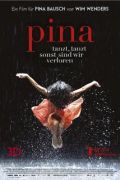
Directed by
Wim Wenders
103 minutes
Rated PG
Reviewed by
Sharon Hurst

Pina
Synopsis:. A tribute to Pina Bausch, Germany’s foremost choreographer, who died suddenly in 2009, and to dance itself as a means of expression.
“Dance, dance or else we are lost”. So said Bausch, about whose life we discover very little from this fabulous documentary. What we do discover however is her dancing philosophy in practice, and the amazing influence she had upon those in her dancing company. Wenders and Bausch were friends for 20 years and so for the director it was a real shock to have his subject die when the film he was making about her was in pre-production. Hence it became a posthumous tribute to Bausch. Friendship aside, it is fitting that Wenders, who has always been at the forefront of art-house film, and unafraid to experiment, should make this film about one of the dance-world’s most experimental choreographers.
Pina is the world’s first 3D art-house film, and it’s inspiring to see 3D used to show dance to its best advantage. We are able to almost feel every gesture, and nuance of emotion and expression, as if we too are on the stage with the dancers. We feel the curtains blowing, the diaphanous costumes, and almost smell the sweat. Excerpts from four renowned pieces are focused upon – Café Muller, Le Sacre du Printemps, Vollmond, and Kontakthof, along with individual pieces by various dancers, some of which are performed out in the streets of Wuppertal and in industrial spaces. The contrast between all these pieces is stunning – in Le Sacre du Printemps dancers, in flimsy shifts, are almost ankle deep in red peat dust, in Café Muller they perform on a minimalist set. Kontakthof is a mind-blowing dance experience in which we as an audience watch another audience watching an array of dancers of all ages moving in formation across the stage, challenging our perceptions of life, aging and dance. In the outdoor dance pieces Wenders makes use of spectacular locations such as mountain tops, forests, and the Wuppertal suspended monorail. A running leitmotif, in which the dancers march forwards chanting “spring, summer, autumn and winter” brings the cycle of life into strong relief.
The stunning way dancers move their bodies to express a range of emotion is just sublime. Employing elements of mime and other theatrical devices they run the gamut of emotion. Love, pain, beauty and sorrow are reflected in all these pieces. And longing, which Pina apparently kept questioning and stressing.
I have rarely seen such intensity of emotion given form by the human body as in this remarkable film. It made me understand why dance can express things that neither words, music, nor paintings can. When the dancers speak (which happens rarely) to Wenders they give us an insight into what Pina meant to them. “Pina was a painter – we are the paint to color her images.” “Meeting Pina was like finding a language.”“Pina told me your fragility is also your strength.”
As a dance-lover, for me everything about this film was mesmerising, but even those who simply appreciate good cinema should get a lot out of this innovative and engaging work of 3D film-making.

Want more about this film?


Want something different?




